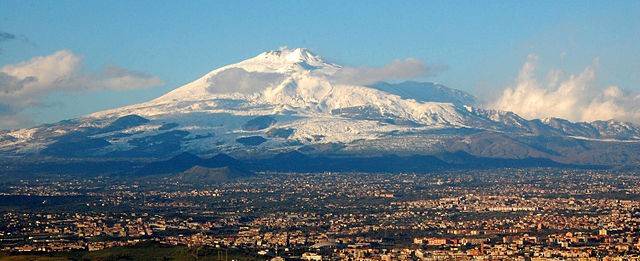Mount Etna, located on the eastern coast of Sicily in Italy, is not only one of the most active volcanoes in the world but also a place of immense natural beauty and cultural significance. Here’s a look at what makes Mount Etna so remarkable:
Key Features and Highlights:
- Active Volcano: Mount Etna is one of the most active volcanoes on Earth, with a recorded history of eruptions dating back thousands of years. Its frequent eruptions make it a significant subject of study for volcanologists.

- Stratovolcano: It is a stratovolcano, which means it has a classic conical shape. It is known for its explosive eruptions and lava flows, which have shaped the surrounding landscape.
- Volcanic Activity: Etna has a complex system of craters, cones, and vents. It experiences both explosive eruptions and effusive eruptions (lava flows). These eruptions contribute to the mountain’s ever-changing topography.
- UNESCO World Heritage Site: The entire area surrounding Mount Etna is designated as a UNESCO World Heritage Site due to its natural significance and rich geological features. The site includes the volcano, its slopes, and the surrounding towns.
- Biodiversity: Despite its volcanic nature, the slopes of Mount Etna are surprisingly fertile and home to a diverse range of flora and fauna. You can find vineyards, orchards, and forests on its lower slopes.
- Hiking and Skiing: Mount Etna is a popular destination for outdoor enthusiasts. Visitors can hike its trails, explore the various craters, and even go skiing on the slopes during the winter.
- Cultural Significance: The volcano holds immense cultural and historical importance in Sicilian and Italian culture. It features in many local legends and folklore. The nearby town of Catania, for example, celebrates the festival of Santa Agata, the city’s patron saint, with devotion to Mount Etna’s protection.
- Geological Research: Mount Etna is a living laboratory for scientists and volcanologists, providing insights into volcanic behavior and the impacts of eruptions on the environment and nearby communities.
- Tourism: Visitors can explore the volcano by taking guided tours, including visits to craters and lava caves, offering a chance to witness volcanic activity up close. Local cuisine often features products grown on its fertile slopes, such as Etna wines and fruits.
Volcanic Hazards:
It’s important to note that while Mount Etna’s eruptions are often closely monitored and its volcanic hazards mitigated, there is still a risk associated with its frequent activity. Visitors are encouraged to follow safety guidelines and heed local authorities’ advice.
Mount Etna stands as a symbol of both natural beauty and potential danger. Its presence and cultural significance add depth to the identity of Sicily and provide a unique opportunity for scientific research and exploration. Whether you’re interested in geology, outdoor adventures, or experiencing a blend of nature and culture, Mount Etna has much to offer.











